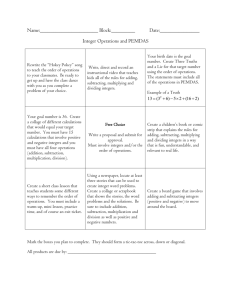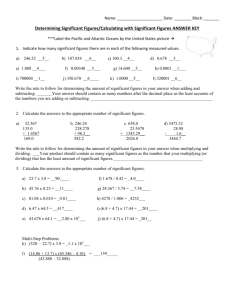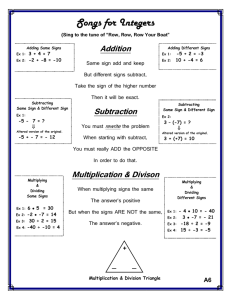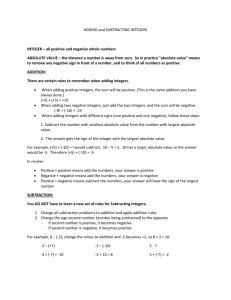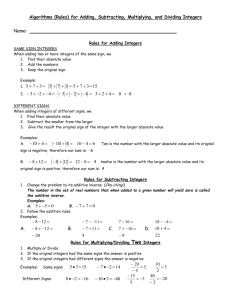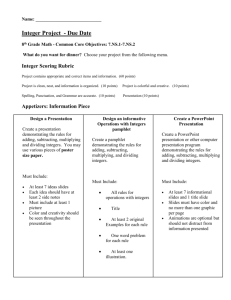Whole Numbers & Integers
advertisement
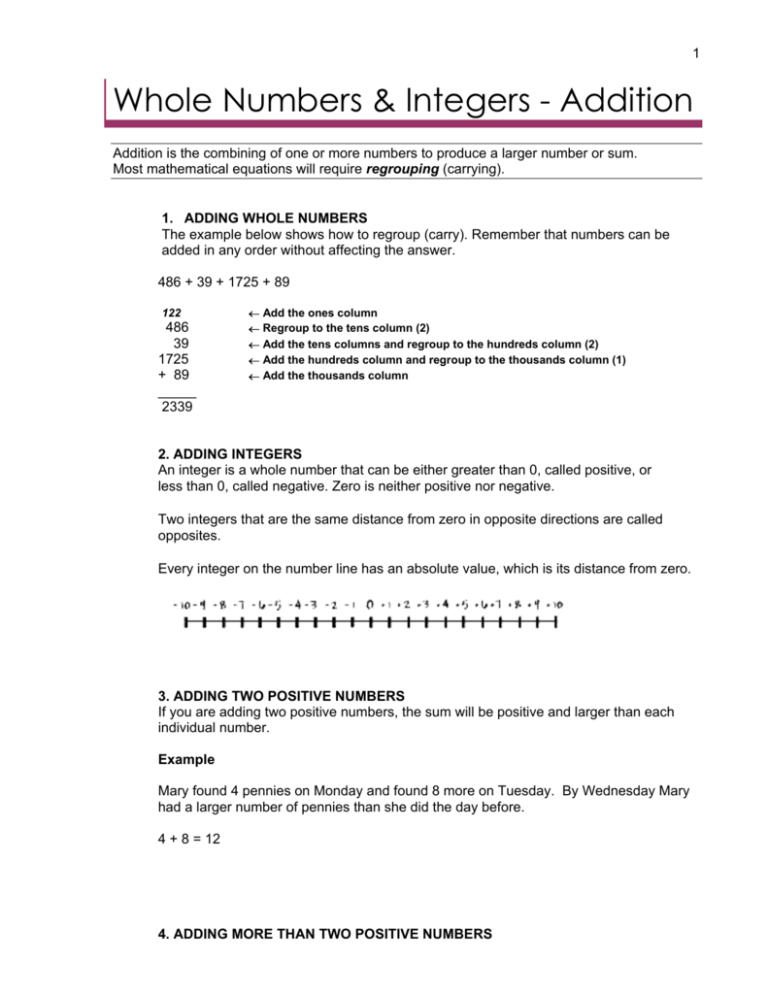
1 Whole Numbers & Integers - Addition Addition is the combining of one or more numbers to produce a larger number or sum. Most mathematical equations will require regrouping (carrying). 1. ADDING WHOLE NUMBERS The example below shows how to regroup (carry). Remember that numbers can be added in any order without affecting the answer. 486 + 39 + 1725 + 89 122 486 39 1725 + 89 _____ 2339 ← Add the ones column ← Regroup to the tens column (2) ← Add the tens columns and regroup to the hundreds column (2) ← Add the hundreds column and regroup to the thousands column (1) ← Add the thousands column 2. ADDING INTEGERS An integer is a whole number that can be either greater than 0, called positive, or less than 0, called negative. Zero is neither positive nor negative. Two integers that are the same distance from zero in opposite directions are called opposites. Every integer on the number line has an absolute value, which is its distance from zero. 3. ADDING TWO POSITIVE NUMBERS If you are adding two positive numbers, the sum will be positive and larger than each individual number. Example Mary found 4 pennies on Monday and found 8 more on Tuesday. By Wednesday Mary had a larger number of pennies than she did the day before. 4 + 8 = 12 4. ADDING MORE THAN TWO POSITIVE NUMBERS 2 When you add more than two positive numbers, the sum will be positive and larger than each individual number. Example Mary found 4 pennies on Monday, 8 more pennies on Tuesday and 6 more pennies on Wednesday. By Thursday Mary had more pennies than she had the day before. More than two positive numbers, can be added in any order. 4 + 8 + 6 = 18 8 + 6 + 4 = 18 6 + 4 + 8 = 18 5. ADDING TWO NEGATIVE NUMBERS When adding two negative numbers, the sum will be negative and smaller than either number. How would you show adding two negative numbers on the number line. How about (-4) + (-3)? The result is negative. (-4) + (-3) = (-7) Example If Mary lost 4 pennies on Monday and 2 pennies on Tuesday, she will have lost a total of 6 pennies. This could be written as; (-4) + (-2) = ← Mary lost 4 pennies and then lost 2 more. (-4) + (-2) = -6 ← Use the number line above. Answer is -6 pennies. 6. ADDING MORE THAN TWO NEGATIVE NUMBERS When adding more than two negative numbers, the sum will be negative and smaller than each of the numbers. As with positive numbers, the order does not matter. You can add negative numbers in the order that makes it simplest for you. Examples (-3) + (-8) + (-2) + (-7) + (-4) = (-24) (-3) + (-7) =( -10) (-8) + (-2) = (-10) (-10) + (-10) + (-4) = 24 7. ADDING NUMBERS WITH MIXED SIGNS When you add a positive and negative number, it is like you are actually subtracting. For example (+7) + (-3) = (+4). The number line shows how to add a positive and a negative 3 number. As you can see, it is like you are subtracting, 7-3=4. Some people say that subtraction is the addition of negative numbers. Examples (+7) + (-3) = (+4) ← As shown in the number line above. (5) + (-8) + (2) = -1 5+2=7 7 + (-8) = -1 8. REVIEW You can use a number line for adding integers: • • Add a positive integer by moving to the right on the number line. Add a negative integer by moving to the left on the number line. 4 Whole Numbers & Integers Subtraction Lesson 2 Subtraction is taking away (a number or quantity) from another number or quantity. 1. SUBTRACTING TWO POSITIVE NUMBERS When you subtract positive and negative numbers, you must follow one rule. To subtract positive and negative numbers, add its opposite. Example (-8) – (+7) = (-8) + (-7) ← Add its opposite. = (-15) The ( + ) sign in front of the 7 was changed to a ( - ) sign. 2. SUBTRACTING TWO NEGATIVE NUMBERS When subtracting two negative numbers, the sign following the subtraction sign ( - ) must be changed. To subtract two negative numbers, add its opposite. Example ( -8 ) – ( -5 ) = = ( -8 ) + (+5) ← Add its opposite as shown in number line. = (-3) The ( - ) sign in front of the 5 was changed to a ( + ) sign. 3. SUBTRACTING NUMBERS WITH MIXED SIGNS When subtracting two numbers with mixed signs, the sign following the subtraction sign ( - ) must be changed. To subtract numbers with mixed signs, add its opposite. Example (-9) – (+6) = ( -9 ) + (-6) = (-15) ← Add its opposite. 5 4. REVIEW You can use a number line for subtracting integers: • Subtract an integer by adding its opposite. 5-8=? Because they give the same result, you can see that subtracting eight from five is equivalent to adding negative eight to positive five. The answer is - 3. To subtract a number, add its opposite: (-3) - (-6) = ? Because they give the same result, you can see that subtracting negative six from negative three is equivalent to adding positive six to negative three. The answer is 3. Whole Numbers & Integers Multiplication Lesson 3 Multiplication is increasing (a number or quantity) by adding the number or quantity to itself repeatedly in a single arithmetical step. 1. MULTIPLYING INTEGERS You multiply integers just as you do whole numbers, except you must keep track of the signs. Multiplication by 0 always produces an answer of 0. 0 is neither positive or negative. 2. MULTIPLYING TWO POSITIVE WHOLE NUMBERS When multiplying two positive whole numbers, the answer is always positive. Example (+ 5) x (+ 8) = (+ 40) 6 The sign, at times, is not written in front of a number when it can be assumed to be positive. The above could have been written; 5 x 8 = 40 3. MULTIPLYING MORE THAN TWO POSITIVE NUMBERS When multiplying more than two positive whole numbers, the answer is always positive and larger than each of the factors. Example 9 x 5 x 2 = 90 4. MULTIPLYING TWO NEGATIVE WHOLE NUMBERS When multiplying two negative whole numbers, the answer is always positive. Example (+7) x (-6) = (-42) 5. MULTIPLYING MORE THAN TWO NEGATIVE WHOLE NUMBERS When multiplying more than two negative whole numbers, the answer is negative if there is an odd number of factors, and positive if there is an even number of factors. Examples (-3) x (–2) x (–5) = (-30) (-3) x (-2) x (-5) =(+6) x (-5) = - 30 There are three factors and three is an odd number, therefore the answer is negative. (-3) x (–2) x (–5) x (–4) = (+120) (-3) x (-2) x (-5) X (-4) =(+6) x (-5) x (-4) =(+6) x (+20) = + 120 There are four factors and 4 is an even number, therefore the answer is positive. 6. MULTIPLYING WHOLE NUMBERS WITH MIXED SIGNS When multiplying a series of whole numbers, the product is negative if the number of negative factors is odd, and positive if the number of negative factors is even. Examples (-3) x (+5) x (–2) x (–5) = (-150) =(-3) x (+5) x (-2) x (-5) =(-3) x (+5) x (-10) =(-15) x (-10) =-150 There are three negative factors (-3, -2 and –5) and 3 is the odd number, therefore the answer is negative. 7 (-3) x (+5) x (–2) = (+30) =(-3) x (+5) x (-2) =(+15) x (-2) = +30 There are two negative factors (-3 and –5) and 2 is an even number, therefore the answer is positive. Whole Numbers & Integers - Division Lesson 4 Division is a process of finding out how many times one number is contained in another. 1. STEPS IN DIVISION The following indicates the basic steps in division. Remember that the number following the division symbol (÷ or /) is the divisor. 3049 6 Example 3049 ÷ 6 or Step One Divide by the number that follows the division sign (÷ or /). Divide into the first number that you can. Since 6 won’t divide into 3, divide into 30. 5 6 3049 Step Two Multiply and Subtract. Bring down the next number. If you can’t divide into it, write zero in the answer before you bring down the next number. 50 6 3049 -30 ___ 04 Step Three Divide 6 into 49. Multiply. Subtract. Write the remainder as a part of your answer. 50 6 3049 8 -30 ___ - 049 48 1 2. DIVIDING TWO NEGATIVE WHOLE NUMBERS When dividing one negative whole number by another negative whole number, the quotient is positive. Example −24 = 3 −8 (-24) ÷ (-8) = 3 or 3. DIVIDING WHOLE NUMBERS WITH MIXED SIGNS When dividing one whole number by another, if one is positive and the other is negative, the quotient is negative. Example −8 = (-2) 4 (-8) ÷ (+4) = (-2) or 4. REVIEW – MULTIPLYING AND DIVIDING INTEGERS You multiply or divide integers just as you do whole numbers, except you must keep track of the signs. When you multiply two integers with the same signs, the result is always positive. Positive x positive = positive Negative x negative = positive When you multiply two integers with different signs, the result is always negative. Positive x negative = negative Negative x positive = negative When you divide two integers with the same sign, the result is always positive. Positive ÷ positive = positive Negative ÷ negative = positive When you divide two integers with different signs, the result is always negative. 9 Positive ÷ negative = negative Negative ÷ positive = negative


